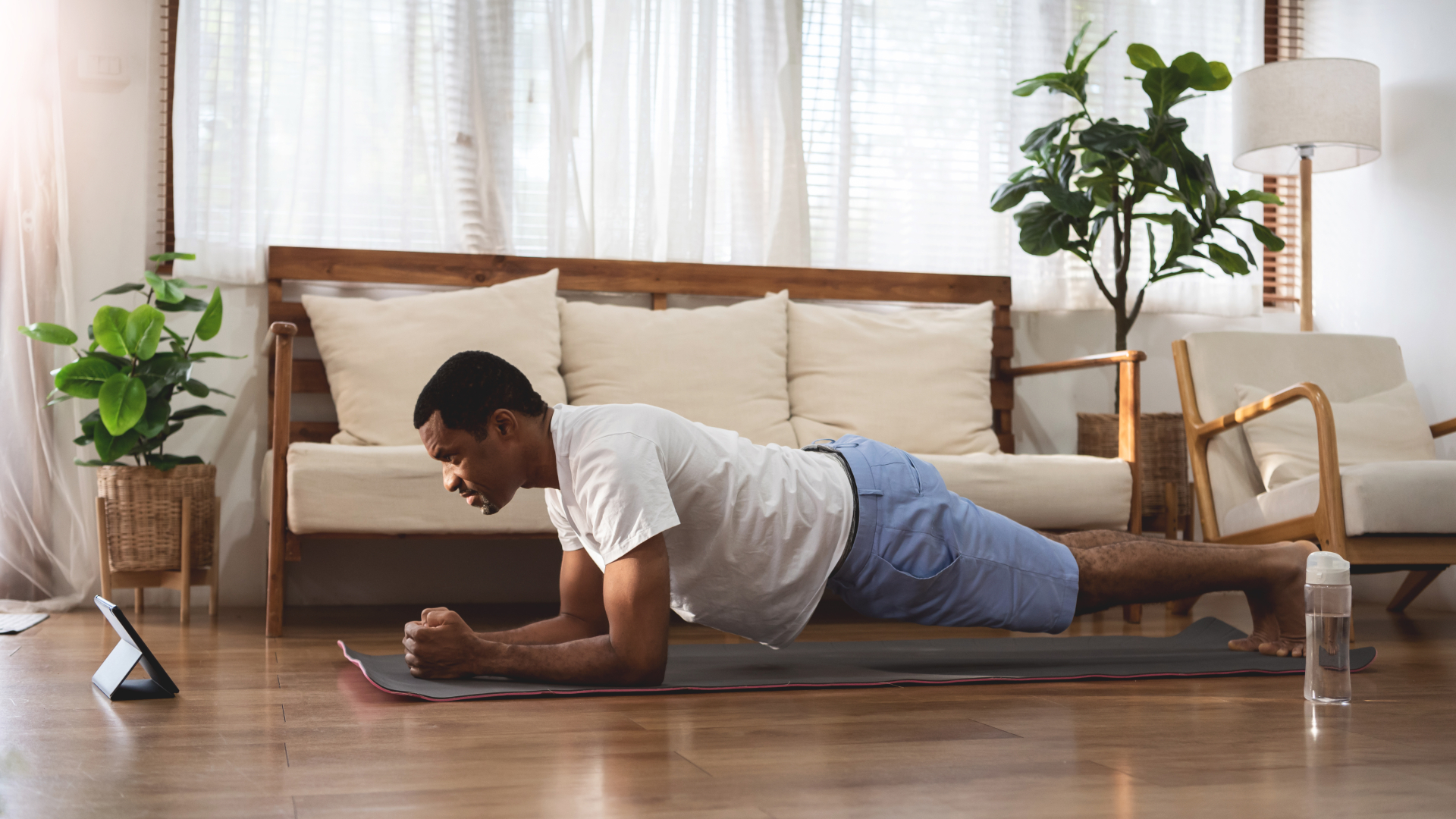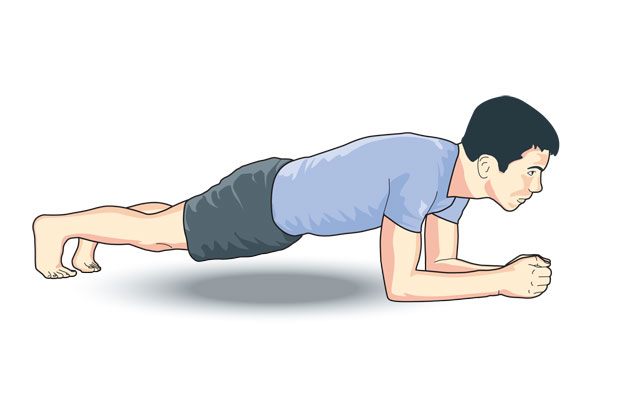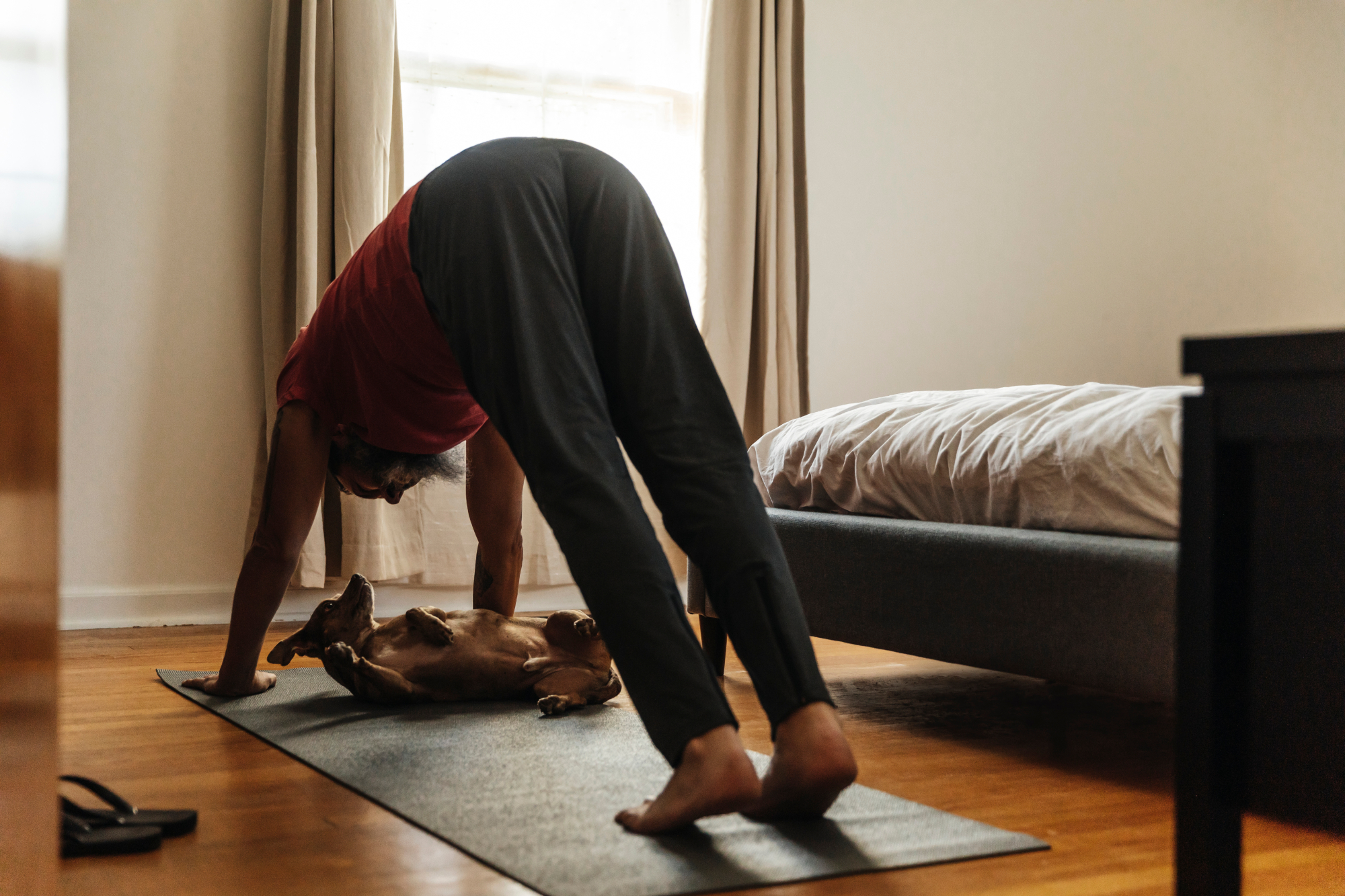Home workout – no gym fees: Try these strengthening exercises for cyclists to stay injury free
Riding your bike without supplementing the pedal strokes with strength and conditioning training is a sure-fire route to injury. Here’s how to bulletproof your body on just one hour a week


"If you want to get fit, ride your bike." That old saw is true enough, in a rudimentary sense, but it ignores a number of important truths. Riding your bike won’t protect you against common cycling injuries, nor ensure good full-body condition, nor guard you against developing physical imbalances.
Of course you want to spend as much time as possible on your bike, but a little time spent doing strength training in the gym — or working-out at home for free — is well worth the small investment of time. Here, physio Sam Mak sets a 30-minute circuit that, if completed twice a week, promises to keep you supple, strong and resilient.
Sam Mak is a chartered physiotherapist at the St James Clinic in London (thestjamesclinic.com) specialising in sports performance. He is also an international-level competitor in Wushu (martial arts).
Why do cyclists need to do off-the-bike conditioning?
Cycling is predominantly one motion — pedalling — with a limited range of movement, using the same muscles repeatedly. This can lead to imbalances. Riders assume they can cycle their way to fitness, but it’s not fitness in the holistic sense. If you don’t address imbalances through exercises and conditioning, your injury risk increases. It's also a factor in finding yourself riddled with lower back pain, neck pain, knee pain or wrist pain.
As well as core conditioning exercises, foam roller exercises can also help with reducing muscle pain, improving range of motion (ROM) and flexibility, as well as for athletic performance, recovery, and injury prevention.
What are the most common issues in cyclists?
Generally, it’s tightness and stiffness, particularly for cyclists who have desk jobs — they’re always sitting, either on a bike or at their desk. While seated, the hip is in its shortest position, the hip flexors aren’t worked, meaning they can get really tight, ditto the hamstrings which could cause injury.
Is flexibility really important for cyclists?
It’s true that the range of motion needed in cycling is relatively limited. But what you need to look at is how a lack of flexibility will impact upon your biomechanics.
If you’re particularly tight in one area, it’ll have a knock-on effect in another area, which can make you susceptible to injury. Having poor flexibility also hampers your ability to hold an aerodynamic riding position.
Are strengthening workouts really worthwhile?
Prevention is better than cure. A little time invested regularly means you’ll avoid time off the bike with injuries. What’s more, you need a strong core for stability — in order to transfer power efficiently to the pedals. To really develop that strength, you need to isolate certain muscles and develop them specifically.
Strengthening exercises for cyclists to stay injury free: 30-minute routine

The warm-up
Perform a simple 10-20 minute warm-up by spinning on a static bike, jogging gently on a treadmill, doing a few star jumps, or by doing a series of slow, controlled squats and lunges — or any combination thereof.
Key guidelines
- Focus on form, getting the exercise right technically and controlling your movement.
Get The Leadout Newsletter
The latest race content, interviews, features, reviews and expert buying guides, direct to your inbox!
- Take 20 seconds rest between each set.
- Complete two circuits — each should take around 10 minutes.
- Do this workout twice a week to injury-proof your body.
- Rep range/holds are flexible to suit fitness of individual — add or subtract accordingly.
Glossary: contraction types
Eccentric exercise/contraction: This is where a muscle is actively lengthening under load. Found to be beneficial for tendinopathy injuries.
Concentric exercise/contraction: In this type of movement, the muscle shortens under load/contraction.
Isometric exercise/contraction: Isometric means the muscle fibres are actively contracting without any change in joint angle or muscle length.
Bulgarian Split Squats

How many?
10-12 reps (on each leg)
Instructions:
- Rest one foot on bench/seat at approximately knee height.
- Assume forward lunge position, keeping the body upright, hips square with rear foot resting on bench.
- Lower the front leg to 90 degrees, keeping the knee aligned with the foot.
- Drive up through the heel to straighten the knee back to starting position.
Muscles targeted:
- Quadriceps
- Gluteus maximus
- Hamstrings
Progress to the next level…
Try destabilised squats by using an unstable surface such as gym ball.
Sam Mak says:
This is a unilateral or single-leg exercise. Bear in mind, when you’re on the bike, you’re extending one leg at a time — and so this exercise is very cycling-relevant. It develops strength and also knee stability, controlling your knee direction, making sure it doesn’t buckle inwards (valgus collapse), which is a common cause of knee injury. Master this exercise and you’ll safeguard good quad function and stabilise knee joints.
Press-ups

How many?
10-15 reps
Instructions:
- Hands below the shoulder, slightly wider than shoulder-width.
- Shoulder, hip and ankles in a straight line.
- Bend elbow to lower chest to just above the floor, keeping the elbows close to the chest.
- Push back up to start position.
Muscles targeted:
- Pectoralis major
- Triceps brachii
- Anterior deltoids
- Core stabilisers (rectus abdominals and obliques).
Progress to the next level…
Push up and descend more slowly.
Raise feet to add weight on upper body.
Change hand position — on knuckles, known as diamond (triceps) push-ups.
Sam Mak says:
Press-ups are another functional compound exercise, this time for the upper body. Keep the elbows tucked in, so you’re working the triceps more and to reduce the risk of injury to the shoulders. Keeping your core tight and body straight, aim to be control the movement. The press-up is a whole-body exercise, so you’re working your upper body, lower body and core.
Romanian Dead Lift

How many?
10-12 reps
Instructions:
- Feet shoulder-width apart, chest up, slight curve in lower back, knees slightly bent.
- Tighten the core and slowly bend at the hips (hip-hinge), making sure the lower back does not move by pushing the bum out backwards.
- At the point you reach the limit of hamstring range, reverse the movement back to the starting position.
Muscles targeted:
- Hamstrings
- Glutes
- Spinal erectors
Progress to the next level…
Add weight by holding a dumbbell, kettle bell or bar
Stand on a box to go beyond normal range.
Sam Mak says:
The Romanian Dead Lifts is great because it works your hamstrings. Research suggests it prevents tendonopathies — the most common type of injury — so it’s well worth mastering. This exercise works the hamstrings through the full range, and it’s one of my favourite exercises.
Plank

How many?
30-40sec hold
Instructions:
- Place the forearms on the ground, elbows shoulder-width apart directly under the shoulder and parallel to the body.
- Push up and hold the body in a straight line (head, shoulders, backside, lower legs).
- Tighten the core by pulling the belly button in towards the spine (without curving the back) and tightening the glutes.
Muscles targeted:
- Core muscles: transverse abdominals, internal/
external obliques
- Gluteals (maximus, minimus, medius)
- Quads, hamstrings, back extensors
Progress to the next level…
Place palms on floor, arms straight.
Perform side plank variant.
Raise feet, balancing them on a Swiss ball.
Lift opposite arm/leg.
Sam Mak says:
A classic core exercise, the plank relies on an isometric static contraction, working the core and gluteus areas efficiently to develop functional stability. Mastering the plank will mean that when you’re on the bike, you’ll be better able to produce power from the core, keeping yourself solid on the bike.
Bridge

How many?
10-15 reps
Instructions:
- Lie on floor with knees bent roughly 90 degrees, feet flat and arms by your side.
- Lift hips up off the floor until the knees, hips and shoulder are in a straight line.
- Squeeze glutes and tighten core to prevent excessive load through the back
- Hold for 2-3sec for isometric contraction, then slowly relax.
Muscles targeted:
- Gluteus maximus
- Hamstrings
Progress to the next level…
Try gym ball bridges — balancing feet on gym ball — or single-leg bridge, or weighted variant, holding dumbbells
Sam Mak says:
The Bridge is another very functional compound movement for the legs, also working the back and core. This is highly relevant to cycling, as on the bike you’re never isolating a single movement — there’s always lots of stuff going on! Make sure you perform this exercise correctly and carefully so as to avoid excessive strain on the back.
Russian core twists

How many?
10 reps
Instructions:
- Sit on floor with the knees bent
- Lean back to roughly 45 degrees, keeping back straight.
- With both hands in front of the chest, tighten the core and lift both legs off the floor.
- Rotate arms to one side, touching the floor around waist level, then twist to the opposite side in the same
motion (= one rep).
Muscles targeted:
- Internal/external obliques
- Rectus abdominals.
Progress to the next level…
Try gym ball core twists or weighted core twists using dumbbell or kettlebell.
Sam Mak says:
This is another dynamic core exercise, only this time you’re starting to work the obliques harder — muscles on the sides of the core. Strength in this area helps prevent rocking from side to side while riding, meaning less power wasted. Stabilising lateral movement in this way is fundamental to maintaining good form on the bike.
Body-weighted squats

How many?
10-15 reps
Instructions:
- Feet shoulder-width apart.
- Head forward, chest up.
- Sit back and down as if onto an imaginary chair. Arch your back slightly as you descend.
- Lower thighs to 90 degrees, keeping knees over your toes and weight in the heels (eccentric contraction).
- Drive through the heels to stand up again
Muscles targeted:
- Quadriceps
- Gluteus maximus
- Hamstrings
Progress to the next level…
Tougher variants are the Goblet squat (holding dumbbell/kettlebell) Barbell front/back squat.
Sam Mak says:
The squat is a compound exercise, meaning it engages multiple muscle groups. Although it’s focusing on the lower legs, hips and back, it’s a very functional movement, working your quadriceps, gluteus, and ankle range of movement — all very important for a cyclist. Squatting is a great way to build up motor pathways and muscle action in critical joints.
Stretches for cyclists

The evidence on stretching is mixed, with no clear consensus about its usefulness. Nonetheless, Sam Mak insists that a streamlined, targeted stretching programme is worthwhile: “Static stretches are best performed after exercise, whereas dynamic stretches are preferable as warm-up.
"Once the muscles are nice and warm after exercise, there is less risk of injury. I believe stretching is important to maintain the pliability of the muscle, how well it’s able to move, extend and contract.”
Lunge hip flexor stretch
30-second hold
Instructions:
- Start a wide forward lunge position with rear knee on the floor, front foot flat on the floor, slightly bent.
- Place hands on front thigh and push hips forward until the stretch is felt in the opposite hip.
- Keeps hips square throughout the movement.
Sam Mak says:
The classic lunge stretches your hip flexors, which are prone to getting very tight in cyclists because of the seated position, in which you never really get your hip into extension. It’s important to stretch the hip flexors because they control pelvic movement and function; if too tight, they can pull down on the hip and cause problems.
Piriformis stretch
30-second hold

Instructions:
- Lying on back, put foot to be stretched above the knee of the opposite leg.
- Bend opposite leg towards the chest, using your hand holding the back of the thigh to pull towards the chest.
Sam Mak says:
The piriformis and gluteus are muscles associated with lower back pain and sciatica, so it’s important to stretch them. Importantly, the piriformis — a small muscle low in the hip — controls hip and lower back movement but is not often stretched in normal movement or day-to-day activities. So, this is a really useful stretch.
Hamstring stretch
30-second hold

Instructions:
- Place one foot on a chair/box in front of you.
- Keeping back straight and hips square, slowly lean forwards towards the foot. Think about leading with the chin to keep the back straight.
- Feel the stretch in the back of the leg.
Sam Mak says:
The hamstrings of cyclists are liable to get very tight because of the lack of extension and range required by the pedalling movement. If they are too tight, the limitation can effect your power distribution and pedalling efficiency. A good range of movement in the hamstrings can have a big impact in performance.
Downward dog
30-second hold

Instructions:
- Start on hands and knees, in a push-up position.
- Slowly push the pelvis up towards the ceiling, keeping the arms straight and breathing out during the movement.
- Be aware of any back/sciatic pains — consult a professional if in doubt.
Sam Mak says:
This yoga pose is a great stretch to cap your session, aiding flexibility in the back and upper body, but it’s important to get it right. It’s a great exercise for the shoulders and the back, and even gets your calves involved too.

Thank you for reading 20 articles this month* Join now for unlimited access
Enjoy your first month for just £1 / $1 / €1
*Read 5 free articles per month without a subscription

Join now for unlimited access
Try first month for just £1 / $1 / €1

David Bradford is features editor of Cycling Weekly (print edition). He has been writing and editing professionally for more than 15 years, and has published work in national newspapers and magazines including the Independent, the Guardian, the Times, the Irish Times, Vice.com and Runner’s World. Alongside his love of cycling, David is a long-distance runner with a marathon PB of two hours 28 minutes. Having been diagnosed with retinitis pigmentosa (RP) in 2006, he also writes about sight loss and hosts the podcast Ways of Not Seeing.
-
 Mathieu van der Poel secures Paris-Roubaix hat-trick after epic duel with Tadej Pogačar
Mathieu van der Poel secures Paris-Roubaix hat-trick after epic duel with Tadej PogačarBy Peter Cossins Published
-
 The Sea Otter Classic: sights and sounds from the biggest bike gathering in North America - Part 1
The Sea Otter Classic: sights and sounds from the biggest bike gathering in North America - Part 1Odds and ends that run the gamut, from a $13,000 frameset to armoured kit and new hydro-vests
By Tyler Boucher Published
-
 Eight simple ways to gain free speed
Eight simple ways to gain free speedHere are our top tips for free speed: all you need are a few simple adjustments
By Zach Nehr Last updated
-
 Save money, fuel better: 20 ways to slash your cycling nutrition costs
Save money, fuel better: 20 ways to slash your cycling nutrition costsWith food prices soaring, it’s getting ever more expensive to sate a cyclist’s appetite. Here’s a nutritionists’ guide on how to cut your fuelling bill – without compromising on health or cycling performance
By Anita Bean Last updated
-
 Five free fitness features on Garmin Connect that cyclists should be taking advantage of
Five free fitness features on Garmin Connect that cyclists should be taking advantage ofHere’s how to make the most of the training software which comes free with Garmin’s cycling computers and smartwatches
By Andy Turner Last updated
-
 Why pay for Zwift when you can ride on MyWhoosh for free?
Why pay for Zwift when you can ride on MyWhoosh for free?With group rides, races, multiple worlds, training plans and workouts, this ad-supported start-up has most bases covered
By Stefan Abram Published
-
 All the essentials to get started cycling indoors (on a budget – or not)
All the essentials to get started cycling indoors (on a budget – or not)Indoor cycling is a fast, efficient way to get fit, here is all you need to get started and beyond
By Luke Friend Published
-
 Gain without pain - here’s the cost-free aero test that every cyclist should try
Gain without pain - here’s the cost-free aero test that every cyclist should tryWhy toil away at hard intervals when you could make bigger gains by effortlessly tweaking your position? We head toa racetrack in search of cost-free aero improvements
By Tom Epton Last updated
-
 16 cost-free, quick and easy fitness hacks for every day
16 cost-free, quick and easy fitness hacks for every dayRiding your bike is just one part of staying fit and healthy. Every spare moment of the day presents an opportunity to boost your wellbeing, here’s what you can do…
By Chris Sidwells Published
-
 Suffering with clunky bike gears? Follow our simple guide to diagnose problems and fix your shifting
Suffering with clunky bike gears? Follow our simple guide to diagnose problems and fix your shiftingFollow our step-by-step guide on how to adjust your bike gears
By Luke Friend Last updated